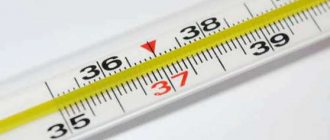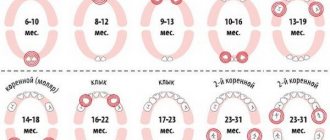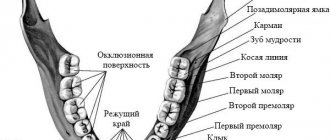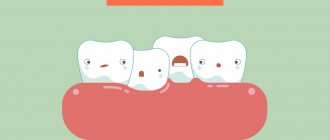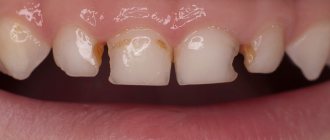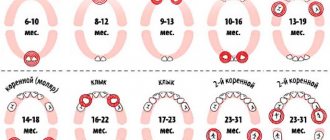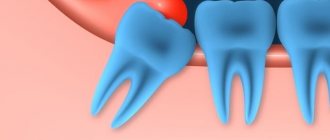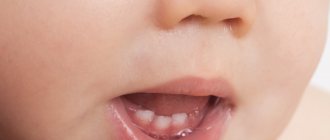Teething is an important event in the life of every child, because he will finally be able to taste solid food. However, the appearance of baby teeth is not always associated with joy and the arrival of the Tooth Fairy. Many children can become irritable and apathetic during the teething period. For some, vomiting, diarrhea, or fever occur when teeth appear.
Whether vomiting is actually caused by teething is controversial. There are no studies confirming the relationship between these natural processes. Most experts agree that teething may cause local pain, but not discomfort in other parts of the body such as rashes or diarrhea.
Other teething symptoms
Some children experience teething without any pain or discomfort. Others may exhibit specific symptoms:
- increased desire to chew;
- salivation;
- cry;
- irritability;
- inability to sleep;
- loss of appetite
- red, tender and swollen gums.
Parents’ concern for the baby’s condition is understandable, because they want to know exactly why the baby’s mood suddenly deteriorated or he began to be capricious.
According to the American Academy of Pediatrics, none of the following symptoms predict the onset of teething:
- cough;
- disturbed sleep;
- decreased appetite;
- vomit;
- diarrhea;
- rash;
- heat.
What is the maximum permissible body temperature of a child during the formation of teeth?
How high a baby's body temperature can rise depends on the condition of his body. During teething, a normal body temperature is considered to be between 37.5 and 37.7 degrees. The maximum permissible temperature is 38 degrees. If it increases further, then measures should be taken to reduce it.
Parents should remember that during the period of formation of baby teeth, the child’s body temperature should be measured more often.
If the child’s body temperature reaches 39 - 40 degrees, this means that urgent medical attention is needed, since, most likely, the infection has penetrated the baby’s respiratory system.
Why does a baby vomit when teething?
Teething is often wrongly blamed for many symptoms. However, research shows that cough, congestion, vomiting, diarrhea, rashes, fever (over 38°C) and sleep-wake problems are not symptoms of teething. In addition, scientists have found that no single set of symptoms can accurately signal the onset of teething.
The American Academy of Pediatrics explains that from the age of 6 months, a child's immune system weakens, losing maternal antibodies, which increases the risk of exposure to a wide range of diseases, including viruses and bacteria. This is why vomiting may have another cause, but not teething.
How to help your baby when he is teething
Teeth are breaking through - it even sounds painful. Indeed, when a baby starts teething, it is often painful. Many children sleep poorly, often cry, and some even develop a fever. But there are other symptoms that indicate your baby is going through the baby teething period. The first signs of teething and, above all, what to do when teeth appear and how to reduce pain will be discussed in a conversation with first category pediatrician Ekaterina Borisovna Bulavina.
— Ekaterina Borisovna, please tell us when do babies usually start teething?
— The timing of teething varies quite widely. On average, the first teeth emerge at 5-7 months, but the process can begin earlier (at two or four months) or take up to a year. And some babies are born with teeth. Everything is very individual and depends on many factors, such as heredity, sufficient calcium intake in the body, the gender of the child, and the climate in the place of residence.
— How quickly will teeth be cut after the first one appears?
— In both boys and girls, the process of complete eruption of the primary dentition usually takes 2.5–3 years. The upper incisors appear 2-3 months after the appearance of the lower ones, then at the age of 9-13 months the upper and lower lateral incisors erupt. From one year to one and a half years, the upper and lower first molars alternately appear, then, by 20 months, the upper and lower canines, and by 2-2.5 years, the second molars. However, the order and timing when babies start teething are very arbitrary.
Table and chart by month: what time do children start teething?
How can you tell if your baby is teething?
— The appearance of teeth, although physiological, is a real test for the child and his mother and father. Only recently have we experienced colic, a feeding and sleeping schedule has been established, when suddenly the baby becomes restless again, is capricious, refuses to eat, or, on the contrary, often and greedily grabs the breast or bottle, sleeps poorly and puts everything in his mouth. These are sure signs that teething has begun.
Some lucky people endure the entire process completely painlessly, and only a casual tap on the gum with a spoon reveals the first tooth that has already erupted. But sometimes the moment of teething is so difficult for the baby that it is easy to confuse it with the onset of the disease.
Only a doctor can determine the real cause of the child’s anxiety, and you should definitely contact him if the temperature rises to febrile levels, severe lethargy, weakness or, conversely, severe excitability of the baby, as well as if signs of infection occur, such as a runny nose, cough, frustration digestion, vomiting, loose stools.
— Ekaterina Borisovna, parents are waiting for the appearance of the first incisors with caution. What symptoms characterize the process besides pain?
— When teeth are cut, the symptoms are very diverse, and everything is individual. In this case, the symptoms may differ depending on the location of the cutting teeth. Usually the most unpleasant sensations accompany the appearance of only the first teeth. All subsequent ones erupt more calmly, and the child practically stops paying attention to this process. When chewing teeth appear, pain may resume, but it is not as intense as at the very beginning of eruption. The appearance of the upper teeth is often accompanied by a runny nose: this is due to the proximity of the location and the single network of blood supply to the upper jaw and nasal cavity.
| First symptoms of teething | Features of the child’s condition and behavior |
| Swelling and redness of the gums |
|
| Excessive salivation |
|
| Decreased appetite or complete refusal to eat |
|
| Increased moodiness |
|
| Temperature |
|
| First symptoms of teething : Swelling and redness of the gums | Features of the child’s condition and behavior
|
| First symptoms of teething Excessive salivation | Features of the child’s condition and behavior
|
| First symptoms of teething Decreased appetite or complete refusal to eat | Features of the child’s condition and behavior
|
| First symptoms of teething Increased moodiness | Features of the child’s condition and behavior
|
| First symptoms of teething Temperature | Features of the child’s condition and behavior
|
— When is it better to lower the temperature during teething?
— Typically, antipyretic therapy is prescribed when the temperature rises above 38.5 degrees. Low-grade fever, up to 38 degrees, should always be brought down in children with organic damage to the central nervous system, with the threat of seizures, as well as with pronounced changes in the general condition of the child.
— Why do you need to carefully monitor your baby’s health during teething? Does teething affect the immune system?
— Teething is a rather complex process in which all systems of the child’s body are involved. The immune system is no exception. When the tooth moves, traumatic damage to the gums occurs and, as a result, inflammation occurs in the tissues. Immune cells rush to the inflammatory focus, trying to eliminate it, which somewhat weakens the local protective reaction. In addition, in abundantly secreted saliva, the content of the enzyme lysozyme is reduced, and it loses its protective properties. In addition, during this period the child puts everything into his mouth, trying to scratch the itchy gums, which increases the risk of infection and injury to the mucous membrane.
— How can parents distinguish teething from other problems, such as a cold?
— It is sometimes difficult even for a specialist to distinguish a viral infection from teething syndrome: very often the two conditions occur simultaneously. With eruption syndrome, the temperature rarely exceeds 38-38.5 degrees, the discharge from the nose is copious, mucous in nature, often transparent. The cough is superficial and occurs more often in a horizontal position. All symptoms are accompanied by profuse salivation. The child's general condition rarely deteriorates; the child is capricious, whiny, but not lethargic or apathetic.
Teething can also be accompanied by symptoms of dyspepsia, such as regurgitation, and sometimes even vomiting, and loose stools. Unlike an intestinal infection, regurgitation and vomiting are episodic and occur when there is an excessive accumulation of saliva.
Liquefied stools may be associated with increased motility due to an increase in temperature - swallowing large amounts of saliva and intense chewing movements. Stool 1-2 times a day, normal color and smell, without pathological impurities, but softer consistency.
If any symptoms appear that do not fit into the picture of teething, you should definitely consult a doctor.
— Does all children experience pain during teething?
— Each child has his own pain sensitivity threshold. The intensity of inflammatory reactions is also different for everyone, so each baby experiences teething differently. If one continuously cries all night, the other may behave in a completely normal way. It depends both on genetics and on the baby’s temperament.
— When teeth are being cut, how can you help your baby? What medications are allowed to be given to relieve pain?
— Pain-relieving gels are widely used. However, you should remember the rules for their use. They have a short-term effect, about 20-30 minutes, but it is not recommended to use them more than five times a day. The gel is applied in a thin layer to avoid an overdose of the drug. And, as is the case with any medicine, do not forget about a possible allergic reaction in the baby.
You can quickly and permanently relieve pain only with anti-inflammatory drugs. And there are a lot of BUTs here. Any drug is unsafe, especially if given for the first time. Only a doctor can assess the child’s condition and prescribe anti-inflammatory therapy if necessary, taking into account the risk-benefit ratio.
Medicines from the group of non-steroidal anti-inflammatory drugs can be prescribed internally. The dosage is calculated by the doctor depending on the weight of the child. Gels with local anesthetic and antiseptic effects are used on the mucous membrane.
— Is it possible to relieve pain and other symptoms with folk remedies?
— Treatment with folk remedies is very popular in our country, although the global scientific community questions its effectiveness. Only exposure to cold has proven effectiveness, so it is recommended to give your child chilled pacifiers and teethers to chew on. Cold causes vasospasm, reduces swelling and inflammation in the gums, and, as a result, pain temporarily subsides. The effect is short-lived, but it still exists. Massaging the gums with a fingertip or soft brush is also helpful.
— Ekaterina Borisovna, tell us in more detail how pacifiers or toys that can be chewed help with toothache, and how to choose a pacifier and a special teether for a child.
— Gum massage helps the baby cope with unpleasant sensations. During the massage, itching decreases, gum tissue softens, and it is easier for the tooth to make its way. But constantly massaging a child’s gums is a very tedious task. He may well engage in self-massage, especially since during this period he himself happily puts everything into his mouth.
Special pacifiers or teethers will be excellent massage assistants. They differ from regular pacifiers in their greater rigidity and textured surface, and are made of latex or silicone. Many models of teethers are equipped with a cooling function - there is a liquid inside that can be cooled. Teethers are also made from plastic, wood or even textiles. But, in my opinion, they do not meet safety standards. It’s worth choosing brands that have been widely represented on the children’s goods market for a long time.
— What techniques can be used to distract a child from toothache?
- In this case, there is only one method - to surround the baby with care and attention as much as possible, pick him up more often, put him to the chest if the child asks. Next to the parents, the baby feels safe and calms down. Children react very sensitively to the behavior and emotions of adults, so it is important for parents to be calm and friendly, to distract the kids with a toy, song, or kind words. You can play finger games with older children. Relaxing massages and long walks are helpful.
Unfortunately, there are no absolutely effective methods. Parents can only help the child cope with the problem that has arisen. But there are some tips that will help you survive this difficult period.
— Please share them with our readers.
— The rudiments of teeth are formed long before birth. Therefore, during pregnancy, mothers should carefully monitor their diet. A sufficient supply of calcium is especially important for the formation of healthy teeth in a baby. But even after birth you shouldn’t forget about calcium. When breastfeeding, the mother's diet should include dairy products or calcium supplements in case the baby is intolerant to cow's milk proteins.
Hardening from birth is the key to good immunity. There is no need to wrap your child in a hundred clothes and be afraid to ventilate the rooms. Walk in any weather and for a long time, use a light contrast shower. And then the baby won’t be afraid of any cold.
Also, avoid public places, especially during the teething period. The baby is very vulnerable at this moment. Postpone visits from relatives, shopping trips and visits to closed playgrounds for a while - thereby you will reduce the risk of infection for your child.
It is also especially important to maintain optimal temperature conditions in the room during this period. Heat and dry air will only increase discomfort.
Teething is a difficult stage in a child’s life. If the process causes severe discomfort, is accompanied by the appearance of alarming symptoms, or high fever, then you should contact a specialist for help as soon as possible. Otherwise, surround your baby with care and attention, select pacifiers, teethers, toys that relieve itching, and use medications with the doctor’s permission. The main thing during this period is to be there and help the baby cope with the pain in every possible way.
Pediatrician Ekaterina Borisovna Bulavina
*The ideal food for an infant is mother's milk. WHO recommends exclusive breastfeeding for the first 6 months. MAMAKO® supports this recommendation. Before introducing new foods into your baby’s diet, consult a specialist.
How to relieve teething discomfort?
To relieve gum discomfort, you can try massaging or rubbing them with your fingers, or giving your baby a chilled teething ring. If your baby is already chewing, you can offer him raw fruits and vegetables.
Do not give your child painkillers or gum rubs, such as viscous lidocaine or benzocaine. These medications may be harmful if swallowed. The US Food and Drug Administration opposes the use of these drugs due to the risk of overdose.
Overdose symptoms include:
- nervousness;
- confusion;
- vomiting;
- convulsions.
Difficulties that arise during the appearance of eights
| Pericoronitis. This is an inflammation of the gum tissue surrounding the visible part of the tooth. If you delay a visit to the dentist, purulent inflammation (abscess or phlegmon) may appear. Manifestation of pericoronitis: severe pain when opening the mouth or while eating, bad breath. In most cases, this disease occurs in 80% of people when the lower eights erupt. |
| Dystopia of the tooth. This is an incorrect position of the tooth in the jaw, that is, the eights can be located horizontally or at an angle. Over time, they begin to push against neighboring ones, leading to their destruction. Most often, dystopia is inherited. To avoid complications, it is recommended to remove dystopic wisdom teeth. |
| Retention. This is when the tooth has partially erupted or not erupted at all. If the tooth does not hurt and does not interfere with its neighbors, then it can be left. Conversely, if a tooth causes unbearable pain and destroys the roots of an adjacent tooth, then it should be removed. |
| Hidden caries . An affected wisdom tooth can cause caries to spread to other teeth; in this case, it is better to remove the tooth. |
When to see a doctor
Teething can usually be managed at home. However, if a child has a high fever and symptoms not related to teeth, this is a reason to consult a doctor.
Some symptoms, such as vomiting, should not be attributed to teething because they may have a more serious underlying cause. Your doctor may want to run some tests to rule out other health problems.
On the Vikids platform you can:
Features of growth
Unlike molars, eights do not have milk precursors in their buds. They erupt after the permanent teeth appear. You can see how this happens in the picture.
Eruption of wisdom teeth depending on age
When molars emerge, a crown forms on the third molar. Then, after a few years, roots begin to grow. Only after the wisdom tooth inside has fully formed does it begin to erupt.
What symptoms can accompany high temperature?
During the period of teething, in addition to elevated temperature, the child may exhibit other symptoms. Often at this time, swelling of the gums occurs, which can reach the mucous membrane of the nose. This phenomenon is accompanied by a runny nose and copious discharge of clear fluid from the nose. Swelling most often occurs when the baby's upper teeth erupt.
If the elevated body temperature persists for five days, then you should immediately call a doctor.
You should also know that during teething, babies produce copious amounts of saliva. It is especially pronounced when the lower teeth erupt.
How long can an elevated body temperature remain?
There is no clear answer to this question. It all depends on the health of the baby. As for the results of long-term observations, on average, the increased body temperature of a child during the formation of baby teeth persists for one to three days. It is important to note that when the top of the tooth appears above the surface of the gum, body temperature returns to normal. This happens as each tooth erupts.
However, statistics show that in some children, elevated body temperature persists for four or even five days, and the fever can last only a few hours and go away on its own.
Knowing all of the above does not mean that parents should not show their baby to pediatricians. An extra examination by a specialist will never hurt, but, on the contrary, will help identify diseases at the earliest stage of their development.
What can a doctor do to reduce the gag reflex?
- Lidocaine. The drug is used for local anesthesia. Lidocaine sprays or gels are usually used.
- Local anesthesia of the palate. This method is used on the upper jaw.
- Conduction anesthesia of the lower jaw. After the administration of the anesthetic, the patient’s cheeks, gums, tongue, and lower lip become numb. Their sensitivity decreases, the doctor is able to carry out therapeutic manipulations normally.
During dental treatment, salivation often increases. Saliva gets onto the root of the tongue, and this increases nausea. To ensure patient comfort, the dentist removes saliva using a saliva ejector. If the reflex is pronounced, you can change the patient’s position and treat him while sitting. This way, less saliva reaches the root of the tongue.
Not only therapeutic procedures, but also diagnostic procedures and impressions before prosthetics or restoration can cause nausea. Here, a lot depends on the methods and equipment used in the clinic.
The 32 Dent clinic uses a new intraoral scanner, Medit 500. It allows you to make a 3D model of your teeth. For the patient, this method offers many advantages compared to traditional impressions:
- Scanning comfort. No powder is needed when using the Medit 500 intraoral scanner. The entire scanning procedure takes place quickly and continuously. The device has a small nozzle, which also reduces the risk that the patient will experience nausea during insertion of a foreign object into the oral cavity.
- High accuracy of results. The Medit 500 intraoral scanner allows you to obtain high-resolution images with minimal error. Thanks to this, the doctor is able to accurately assess the condition of the oral cavity and not carry out additional diagnostic procedures.
- High speed. The image obtained during scanning is immediately displayed on the monitor. In order to obtain a 3D model of the oral cavity, approximately 2 minutes are enough - about a minute for one jaw. Even if the patient has a strong gag reflex, in most cases, attacks of nausea do not occur in such a short period.
- Possibility to interrupt scanning and start it from the desired point. The Medit 500 intraoral scanner is turned on and off with a button. If the patient feels nausea or vomiting. The doctor can take a break and continue the scan from where he left off.
The use of modern intraoral scanners helps our doctors make not only treatment, but also diagnostic procedures comfortable.
